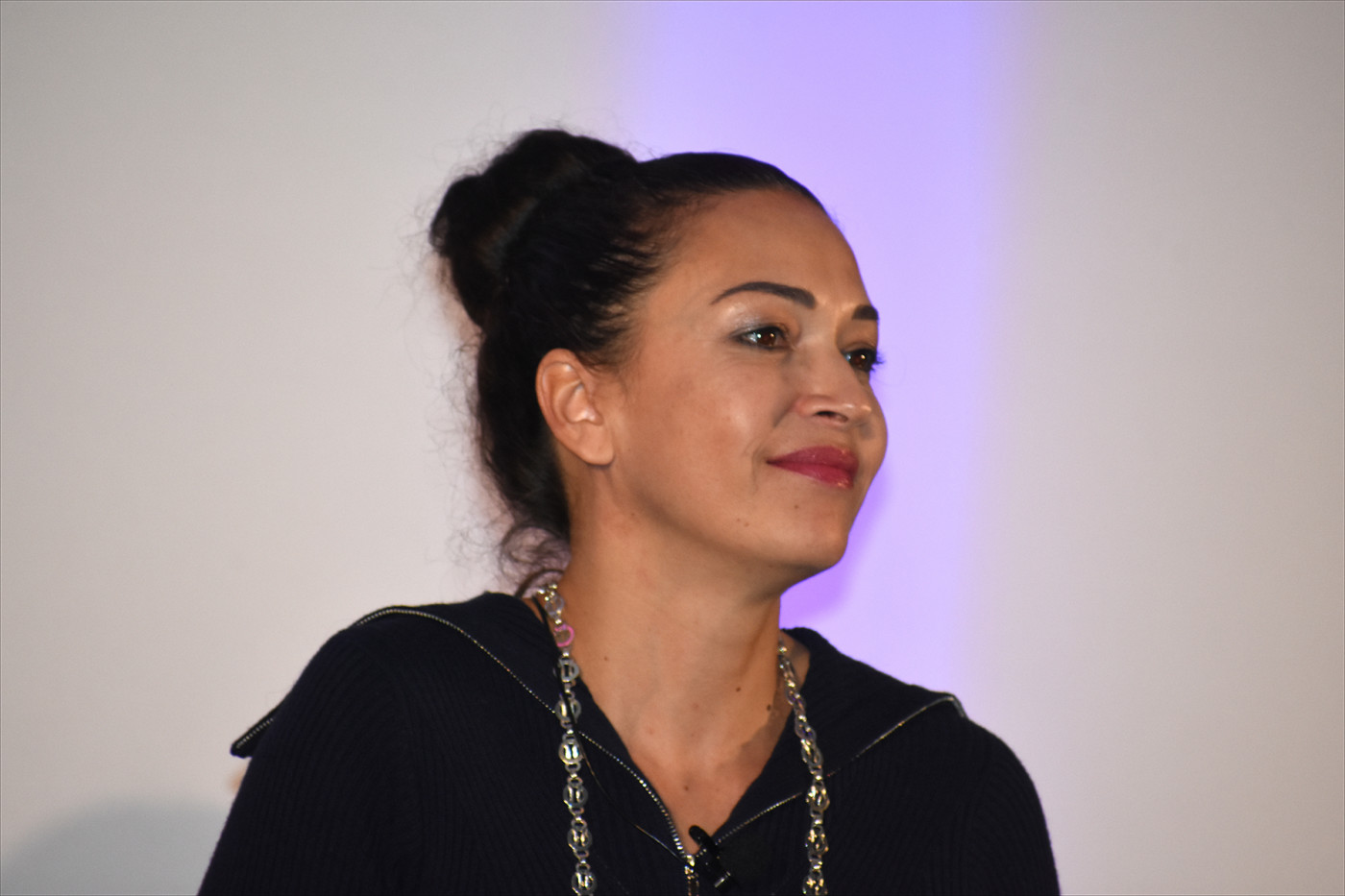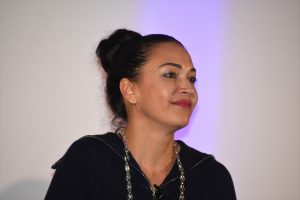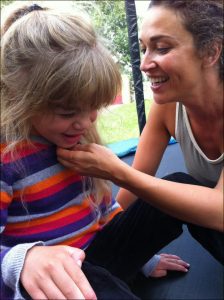Lysogene CEO Karen Aiach, Inspired by Daughter, Determined to Treat Sanfilippo
Written by |

Karen Aiach, founder and CEO of Paris-based Lysogene, speaks at the NORD Summit in Washington. (Photo by Larry Luxner)
Karen Aiach never imagined she’d one day start a drug company dedicated to curing a fatal genetic disease. But that was before 2005, when the French business consultant gave birth to a baby girl with Sanfilippo syndrome type A, also known as mucopolysaccharidosis type IIIA.
Aiach, 48, is the CEO of Paris-based Lysogene, which owes its existence to Aiach’s daughter, Ornella, who died in December at the age of 15.
Diagnosed with Sanfilippo at 6 months old, Ornella began speaking at a normal age, but lost the ability to form words shortly after her third birthday. By the age of 10, she needed help with walking, and by age 13, she had completely lost her ability to walk.
Ornella’s early diagnosis is unusual, because children in Europe tend not to be diagnosed before age 4; in the United States, it’s even later. Ornella’s younger sister, Salomé, 13, is healthy.
“It was just a question of life or death for me,” Aiach told Sanfilippo Syndrome News in a recent interview. “I knew that it was a race against time for Ornella. Her doctor had been an intern years before, so when he saw Ornella with a slight spleen enlargement, he didn’t want to alert us too early.
“After the second month, he said there was something he didn’t like — and that if she still had that after four months, we’d need to consult a specialized hospital in Paris.”
That’s when Aiach got the bad news.
“I entered the rare disease community in 2005 when patient advocacy groups were really the entry point for this amazing world,” Aiach said. “At that time, no one would talk about Sanfilippo syndrome. There was no cure, and almost no research either.
“Some therapies had emerged for lysosomal storage disorders, mostly based on enzyme replacement therapies. But these are very big molecules that will not cross the blood-brain barrier,” she added. “Doctors told me to just take care of my child and wait for the ultimate outcome.”
Aiach said her business degree and experience working for seven years at the Arthur Andersen accounting firm helped to prepare her for the enormous challenges of the pharmaceutical world.
“I was used to working on complicated stuff with people from different countries. I was at ease with numbers, money, companies and structures, so I started my own company with a patient group trying to understand the disease and the world of drug development,” said Aiach, whose journey from Paris accountant to international pharma company CEO was part of a 2015 article in the New York Times.
LYS-SAF302 gene therapy offers hope
Sanfilippo syndrome affects roughly 1 in 100,000 newborns, with a total of 3,000 to 4,000 cases already diagnosed in North America and Europe, and around 100 new cases found annually.
Inherited in an autosomal recessive pattern, MPS IIIA is caused by mutations in the SGSH gene, which encodes a necessary enzyme for breaking down large sugar molecules called glycosaminoglycans. The lack of this enzyme in children with MPS IIIA leads to severe neurodegeneration and early death.
“This enzyme cannot be delivered intravenously, and no one would think of injecting it into the brain of a patient every week,” Aiach said. “So the question was how to have this enzyme manufactured and expressed into the brain. The only way to do that is gene therapy.”
Children with the disease usually develop profound mental retardation, hyperactivity, and sleep disorders. Physically, they often have wide eyebrows, wide lips, and a flat nose.
Lysogene has identified more than 150 mutations among Sanfilippo patients; most are associated with the severe, classical form of the disease. Ornella had a mutation specific to Jews of Sephardic (North African or Middle Eastern) origin.
“During the first two or three years of life, the child will develop almost normally in appearance. Then, by kindergarten, people will realize there is a difference,” Aiach said. “Quite often, the parents will have detected something wrong earlier than that — because children with MPS IIIA will start plateauing around the age of 2 or 3.”
At age 6, Ornella — along with three other Sanfilippo patients — was given LYS-SAF301 in a clinical trial (NCT02053064). This one-time gene therapy has now been replaced by LYS-SAF302, a more fully optimized version also designed to replace the faulty SGSH gene with a healthy gene copy.
It does this by employing a harmless adeno-associated virus known as AAVrh10, which is delivered directly into the brain during a two-hour surgery.
“For six years, Ornella wouldn’t sleep at night. It was completely exhausting,” Aiach said. “The treatment brought her a big benefit in terms of sleep and reduced hyperactivity. It was really a major change. I saw this with my child and the other three in the study.”
Phase 2/3 trial underway
In February, the U.S. Food and Drug Administration (FDA) granted Lysogene fast track designation for LYS-SAF302. Lysogene maintains commercial exclusivity of this potential therapy in Europe, while Sarepta Therapeutics — under an October 2018 agreement — owns rights for the U.S. and all other markets.
“I was not a scientist or clinician and never pretended to be,” she said. “My job is to help these other people do their jobs, and concentrate on the essentials: working on regulatory affairs, clinical trials, and fund their work. Everyone has their part, but science is unpredictable, and very often we have results we’re not happy with.”
Lysogene’s Phase 2/3 AAVance trial (NCT03612869) consists of 20 patients, ages 6 months and older, 19 of whom have already been dosed. Its primary goal is changes in cognition with treatment; others are behavior, sleep, and quality of life. All enrolled are being given the gene therapy candidate via an injection to both sides of the brain.
“We have considerably increased the knowledge and data of the disease’s natural history,” Aiach said. “We do not want to have a placebo control group. These patients are vulnerable. We will never do a sham surgery. No parent will want his child to be in the untreated arm of the study.”
The study is taking place at four U.S. sites (in California, Minnesota, New York and Texas) as well as sites in England, France, Germany and the Netherlands. But recent findings on MRI exams that suggested the injection delivery of LYS-SAF302 may be causing damage to some patients’ brains led the FDA to put a hold on this trial.
The company is gathering data to better understand the therapy’s safety profile, and believes that current trial timelines will not be affected by the hold.
Since forming Lysogene, Aiach and her 20-person team have raised about $100 million from investors, though it has no revenues as of yet. Besides Sanfilippo, the company is also pursuing potential therapies for GM1 gangliosidosis, which is related to Tay-Sachs disease, as well as fragile X syndrome.
Even if LYS-SAF302 cannot cure children with Sanfilippo, Aiach said, it offers hope for a better quality of life — though Lysogene’s second-generation, improved gene therapy came too late for Ornella.
Any gene therapy that Lysogene might win approval to market will likely cost hundreds of thousands of dollars, if not more. The Novartis one-time gene therapy Zolgensma (onasemnogene abeparvovec), which treats spinal muscular atrophy, carries a list price of $2.125 million.
“Our drug will be expensive; otherwise, the company would not exist. We are talking about a life-threatening, lethal disease,” Aiach said. “We started talking with payers years ago to make sure that in our Phase 3 study, we include tools they want us to use.”
She added: “I promised Ornella I would continue fighting until there’s a drug on the market. We will do everything we can to show that this drug is efficacious, because every day is a day lost against this disease.”






